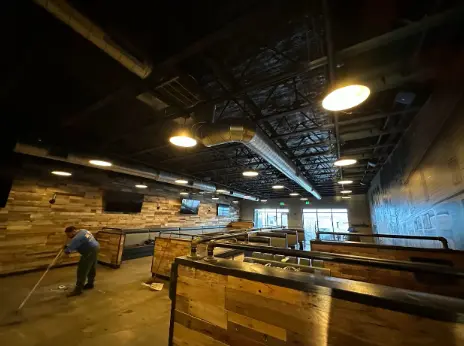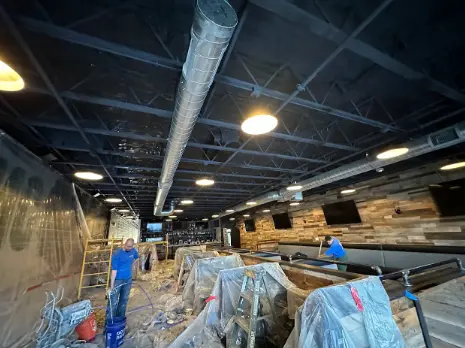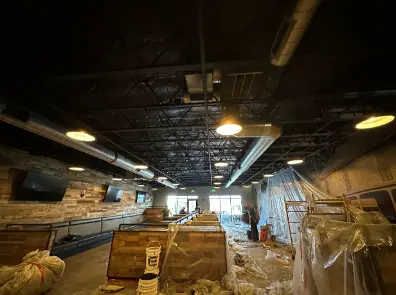California Restaurant Insulation Options: Cost, Pros & Cons

Key Takeaways
- Insulating your restaurant in California can significantly reduce energy costs and improve comfort for both staff and patrons.
- Spray foam insulation offers superior thermal resistance for a higher upfront cost.
- Fiberglass insulation is a cost-effective option but may not provide the same level of energy efficiency as other types.
- Reflective insulation is ideal for hot climates like California but may not be suitable for all areas of your restaurant.
- USA Spray Me offers spray foam insulation that can lead to long-term savings and a faster return on investment.
Insulation Options for Restaurants in California
Why Insulation Matters for Your Restaurant
Insulation is essential for maintaining a consistent temperature inside your restaurant. Proper insulation helps keep the heat out during summer and retains warmth during winter - making your restaurant more comfortable for your staff and customers. Quality insulation can also reduce energy consumption and save money in the long run.
USA Spray Me is an insulation company based in San Francisco and serving Northern California. Our expert technicians specialize in the application of high-quality foam polyurethane insulation, known for its superior thermal performance and air-sealing properties.
Get a Quote for Your ProjectHow to Optimize Energy Efficiency in Your Restaurant
- Walls: Use high R-value insulation to minimize heat transfer and maintain a consistent indoor temperature. The R-value measures the insulation's resistance to heat flow—the higher the R-value, the better the insulation's effectiveness. High R-value insulation ensures superior thermal performance, making indoor space comfortable and energy-efficient.
- Roofs: Reflective insulation can help reduce heat gain from the sun, keeping your restaurant cooler during hot weather.
- Floors: To maintain a warm environment during colder months, insulate floors to prevent heat loss - especially if your restaurant is on the ground floor.

Types of Insulation
Fiberglass Insulation
Fiberglass insulation comes in batts or rolls and is relatively easy to install - however, it may not provide the same thermal resistance level as other insulation types.
Spray Foam Insulation
Spray foam insulation offers superior thermal resistance but has a higher price tag. It can provide significant long-term savings if you can afford the initial investment.
Blown-in Insulation
Blown-in insulation is particularly useful for insulating hard-to-reach areas and can be installed quickly. The cost is moderate, making it a good balance between performance and affordability.
Pros and Cons of Common Insulation Types Used in Restaurants
| Type of Insulation | Advantages | Disadvantages |
|---|---|---|
| Fiberglass | Cost-effective, Easy to install, Fire-resistant | Can irritate skin and lungs during installation, Less effective in very cold or hot climates, May sag over time, reducing effectiveness |
| Spray Foam | High R-value per inch, Seals gaps and cracks effectively, Long-lasting and durable | Higher upfront cost, Requires professional installation, Can be messy to apply |
| Blown-in | Good for irregular spaces, Moderate cost, Quick installation | Can settle over time, reducing effectiveness, May require additional support in walls, Can be dusty during installation |
| Reflective | Highly effective in hot climates, Lightweight and easy to install, Reduces cooling costs | Less effective in cold climates, Requires an air space to be effective, Can be punctured easily |
| Rigid Foam | High R-value per inch, Durable and long-lasting, Resistant to moisture | Higher cost, Requires precise cutting and fitting, Not flexible, can be difficult to install in irregular spaces |
This table provides a detailed comparison of the pros and cons of various insulation types commonly used in restaurants.
Cost Analysis:
| Type of Insulation | Cost per Square Foot |
|---|---|
| Fiberglass Insulation | $0.40 to $1.50 |
| Spray Foam Insulation | $1.00 to $4.00 |
| Blown-in Insulation | $1.00 to $2.00 |
| Reflective Insulation | $0.50 to $1.50 |
| Rigid Foam Panels | $1.20 to $3.00 |
This table compares different types of insulation and their respective cost per square foot.
Long-term Savings and ROI
While the initial costs are important, the long-term savings can make a more expensive option worthwhile. Spray foam insulation, though pricier upfront, can save you significant energy bills over time due to its superior thermal performance.
Cost-effective Options
Fiberglass and blown-in insulation balance cost and performance if you're on a tight budget. These options are less expensive to install and still provide decent thermal efficiency.
Environmental Impact
Eco-friendly Insulation Options
Several eco-friendly insulation materials are available from recycled or natural materials. These options help the environment and provide good thermal resistance. Some popular eco-friendly insulation materials include:
- Cellulose Insulation: Made from recycled paper, it's also treated to be fire-resistant.
- Cotton (Denim) Insulation: Made from recycled denim fabric, it's safe to handle and effective.
- Sheep’s Wool Insulation: A natural, renewable resource that’s fire-resistant and good at regulating humidity.
Sustainability Considerations
When choosing insulation, consider its entire lifecycle, from production to disposal. Look for materials that are sustainably sourced, have low embodied energy, and can be recycled at the end of their life. Also, consider the insulation’s impact on indoor air quality; some materials may off-gas harmful chemicals.
Regulatory Requirements
The California Title 24 Building Energy Efficiency Standards set requirements for insulation in commercial buildings, including restaurants. Ensure your insulation choice complies with these regulations to avoid legal issues and qualify for potential rebates and incentives.
Choosing the Right Insulation
Choosing the right insulation for your restaurant in California is a crucial decision that can impact your energy costs, customer comfort, and overall sustainability. With various options available, it's important to weigh the pros and cons of each type and consider both initial costs and long-term benefits.

Why Choose USA Spray Me for Your Restaurant Insulation Project
At USA Spray Me, we bring over ten years of experience in providing top-quality insulation solutions tailored to your restaurant's unique needs. Our team of experts helps you choose the best insulation materials and ensures a flawless installation process. We customize our solutions to your specific needs and budget - while complying with all local building codes and regulations.
Get a Quote for Your Restaurant Insulation ProjectFrequently Asked Questions (FAQ)
How do I choose the best insulation for my restaurant?
Choosing the best insulation depends on several factors, including your budget, the specific areas that need insulation, and the climate. Options include fiberglass, cellulose, and spray foam. Spray foam is highly recommended for its superior thermal performance and ability to seal gaps and cracks. Consulting with a professional insulation contractor can help you make an informed decision suited to your needs.
What are the most cost-effective insulation options?
Fiberglass and blown-in insulation are generally the most cost-effective options. However, they may not provide the same level of thermal resistance as more expensive options like spray foam or rigid foam panels.
How does insulation impact energy bills?
Proper insulation can significantly reduce your energy bills by minimizing heat transfer and reducing the workload on your heating and cooling systems. This leads to lower energy consumption and cost savings over time.
Are eco-friendly insulation materials worth the investment?
Eco-friendly insulation materials can be worth the investment to reduce your environmental footprint and improve indoor air quality. While they may have a higher upfront cost, the long-term benefits can outweigh the initial expense.
What are the common mistakes to avoid when insulating a restaurant?
Common mistakes include choosing the wrong type of insulation for your climate, not sealing gaps and cracks properly, and failing to comply with local building codes and regulations. Working with a professional can help you avoid these pitfalls.
How can I maintain the efficiency of my existing insulation?
Regular maintenance, such as checking for gaps or damage and adding additional insulation if needed, can help maintain the efficiency of your existing insulation. Ensuring your HVAC system is well-maintained can also improve overall energy efficiency.
Why Should I Choose USA Spray Me?
USA Spray Me guarantees expert advice, premium-quality materials, and unparalleled customer service. Based in San Francisco, our dedicated team is committed to maximizing energy efficiency and comfort for your restaurant. With over ten years of experience, we specialize in insulation and waterproofing, using materials from leading suppliers and proven technology. Our services focus on energy efficiency, cost savings, comfort improvement, noise reduction, and environmental impact, making us the ultimate choice for your insulation needs in the San Francisco area.
